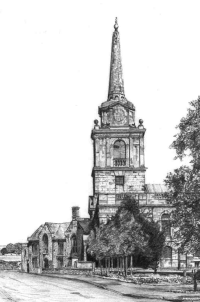|
Church of the Holy Cross at Daventry, and Church of St. Peter and St. Paul at Preston Capes
Permission for use of drawing of the Church of the Holy Cross by Christopher Marshall was granted by Paul Marshall, July 2, 2001 |
 |
| The Bliss families of Rehoboth
and Newport have historical ties with the Church of the Holy Cross at
Daventry and the Church of St. Peter and St. Paul at Preston Capes.
It was at Daventry that William Blysse (b. 1530-35) was buried July 20, 1574, and his son, John Blisse was baptized Feb 2, 1562. John's son, Thomas It was at St. Peter and St. Paul that John Blisse was buried September 8, 1617. His second wife, Alice Smith, the mother of John Blisse (born 1615-1616) was buried there on March 26, 1625. The present building of the Church of the Holy Cross was erected in the 18th century, but its pedigree goes back to 1066 or earlier. The church in Daventry would have been a place from which missionaries went out to minister and preach. Hugh de Leycester, founded a Cluniac Monastery at Preston Capes in 1090 and moved with several monks to Daventry in 1108, taking over the church and erecting a priory to the honor of St. Mary of La Charite and St. Augustine near the site of the present church. By the 14th century, eighteen monks were attached to the Daventry site. By 1752, Daventry's growing population necessitated church expansion, a fire had occurred, and the church was aging. The Bishop of Peterborough suggested that the old church be demolished and a new one erected. A new church was started in 1752 and completed six years later. Northamptonshire brown ironstone was used in the construction, and the total cost, including bells and chimes, was £3486. The church has a peal of ten bells dating from 1738. Parish registers. dating from 1560, are now kept at the County Record Office, but a collection of books from the 16th century are kept in the church. The present building of the Church of St Peter and St. Paul in Preston Capes dates to at least the mid-12th century. The arcade in the south aisle dates from that time; the north arcade is thought to have been constructed 200 years later. Dark ironstone was used in the construction of the south arcade and light-colored limestone was used for the north arcade. Corbels, representing the eight King Henrys, were used where the arches join the columns. The churchyard contains a number of graves dating to the 1600s as well as the base of a former preaching cross. It was around this cross that people gathered to worship while the church was being built. Source: Churches in & around Daventry by Ron Wilson. ISBN 1 899293 76 0 |
|
| Church of the Holy Cross and Daventry Resources |
Church of St. Peter and St.
Paul and Preston Capes |
|
Chris Marshall's Fine Pencil Drawings of Northants and other locations |
|
|
|
|